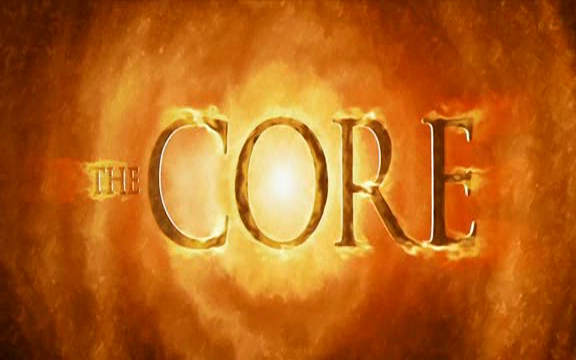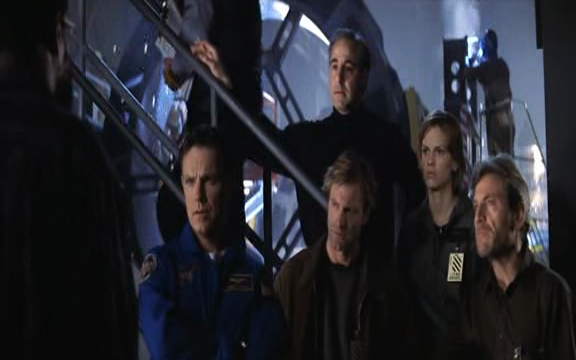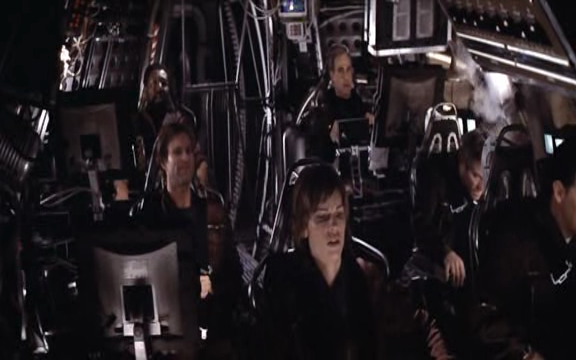
#27 – The Core (2003)
The Core (2003)
Film review #27
Director: Jon Amiel
A sci-fi disaster film giving the B-movie sci-fi movie plots of yesteryear a big Hollywood makeover…
A number of strange incidents are occurring all over the planet, including people’s pacemakers stopping, pigeons falling out of the sky, and calculation errors aboard a U.S. space shuttle. Dr. Josh Keyes, along with his friend Serge Leveque do some investigating and find that the only explanation is that the Earth’s core has ceased it’s rotation, causing the magnetic field of the planet to disappear. Alarmed at what they find, they approach a top government scientist, Conrad Zimsky to confirm their findings. He unfortunately has to agree with the results. At a government meeting, the three explain to the politicians that if something is not done to restart the core’s rotation, the planet will succumb to a series of disasters and become completely irradiated without the Earth’s magnetic field to protect it from cosmic rays. Their plan: To plant a series of nuclear charges in the core to restart the core’s rotation, but in order to do that, they will need to travel to the centre of the Earth, which seems impossible. However, Zimsky has an idea…
Keyes, Leveque and Zimsky travel to the salt plains to Utah to meet a scientist named Ed Brazzelton (nicknamed “Braz”) who shows them his plans for a ship that could travel to the core, and an ultrasonic laser which could drill it’s way there. The ship would survive by being constructed with an element he has jokingly named “unobtanium”. He is reluctant to work with Zimsky, who took credit for his research some twenty years ago, but is swayed to construct this ship for them when they offer him the fifteen billion dollars needed to build it. Joining them is Rebecca “Beck” Childs, the pilot that helped save the Endeavour shuttle from crashing into L.A. earlier in the film, and her mentor and commander Robert Iverson to round off the crew, and the six of them train to complete their mission to save the planet, helped by Theodore Donald “Rat” Finch, a hacker who suppresses information on the internet to avoid mass panic and keeping the public from finding out what is happening to the planet.
When the ship is finally completed, the team have no time to lose and prepare to set off. Braz has named it Virgil, after the poet that guided Dante through Hell and to the centre of the Earth in the epic poem The Divine Comedy. As they travel through the Earth’s mantle, they enter a geode and get stuck on a crystal like structure. Braz, Keyes and Iverson exit the ship to cut the crystal away from the ship, but it is a race against time as the geode is starting to fill with magma from the hole the ship made. The crystal is cut, but a piece of falling crystal pierces Iverson’s helmet, killing him instantly. The ship sets off again, but is soon hit by a huge diamond, damaging one of the compartments. Leveque sacrifices himself to get the nuclear launch codes out the compartment of the ship that is jettisoned and crushed. Keyes screams to Beck to open the bulkhead and let him rescue Leveque, but Zimsky warns her not to, and she listens, much to Keyes’ anger at feeling he could have saved his friend.
When they head into the outer core, they find a severe flaw in their original plan, the density of the core means that they don’t have enough firepower to restart the core. Zimsky radios to the surface to activate DESTINI, a secret project that could propogate earthquakes through the Earth’s core. Keyes refuses to abort their mission, meaning that when DESTINI fires, it will destroy Virgil. Zimsky snaps at Keyes saying he has no plan and he is going to kill them all. While Braz and Keyes are trying to figure out a plan unsuccessfully, Zimsky interrupts and comes up with one of his own: To eject each of the nuclear bombs in a seperate section of the ship at seperate times to create a cumulative ripple that will have enough power to start rotation. Keyes contacts Finch to hack into project DESTINI and delay it to allow time for them to complete their mission. Braz remarks that someone needs to deactivate a safety switch to jettison compartments manually, and whoever went would die because of the extreme heat in the tunnel. Braz himself volunteers and dies shortly afterwards.
As they are jettisoning the compartments, Zimsky and Keyes realise that the final bomb does not have enough power to accomplish their mission. Zimsky then becomes trapped in a compartment, and tells Keyes to use the plutonium that’s powering the ship to create enough power in the final bomb before the bulkhead shuts and Zimsky is jettisoned with the ejected compartment. The ship is now trapped without power, but Keyes has a plan to rig the unobtainium up like a solar panel to power the ship through the planet, the explosions successfully start the core rotating, and they arrive out of the core at the bottom of the ocean. They think they are lost their without power, until Finch finds them by tracking the whales circling the vessel. Keyes remarks that no one will ever know how close the planet came to destruction, and of the sacrifices of Iverson, Leveque, Braz, and Zimsky. That is, unless someone manages to leak that information. One week later, we see Finch sit down in an internet café, and uploads the details of what has happened onto the internet, and revealing the noble sacrifices of the heroes that saved Earth…
The Core is very much a big budget Hollywood take on the plots and concepts of old B-movies such as The Day The Earth Stood Still or War of the Worlds, in which a disaster is affecting the entire planet. The big difference between The Core and it’s predecessors has to be the use of special effects: Being able to convincingly create the image of a ship tunnelling through the Earth, or a freak thunderstorm wiping out Rome and the colosseum really drives home that sense of disaster. These special effects weren’t really cutting-edge for their time, but compared to the B-movies of yesteryear, they are amazing, and one might wonder what those old movies would look like with a Hollywood makeover (Then you should remember some of the recent Hollywood remakes that were terrible, and should forget all about that idea…). Despite the scale the disaster is shown on though, I found the movie to be a fairly easygoing affair, and quite an enjoyable journey. When I first saw that the movie was two hours long I figured I was going to either have to wait a while for it to get going, or I’d get bored half way through, but that never happened. The movie starts off strong and eases you in to a comfortable pace with some well defined characters with enough personality that makes those two hours really enjoyable. Not stand out amazing, but enjoyable.
This movie wasn’t so successful in the U.S. when it was launched, and only turned a profit when it was released worldwide. The main reason this movie is remembered is because of it’s numerous scientific inaccuracies, and is often slammed by scientists (In a poll which asked scientists about the worst science-fiction films, The Core was voted the worst). There are a lot of liberties taken with science in this movie, so it’s difficult to pick just one out. I suppose the worst offender would be that the loss of the core’s rotation would not have the effect it has in the movie: Pigeons would not start falling out of the sky, pacemakers would not just shut down, and “superstorms” would not occur and wipe out entire cities. If the core did stop rotating, the immense energy from the rotation would instead dissipate outwards into the mantle and evaporate the oceans, which would be a much more serious issue. The energy needed to theoretically restart the core (Which isn’t possible, since it just wouldn’t stop) would be equivalent to 500 times the amount of nuclear weapons in the world, rather than the 5 they use in the film. The worst effect of the core ceasing rotation in the movie is the loss of protection from “cosmic rays” that the magnetic field gives. While this is partly true (depending on what type of “cosmic rays” one refers to), the movie refers to “microwaves” being the main problem, but in fact microwaves aren’t affected by magnetic fields, and the sun does not put out enough energy in microwave form to make much difference anyway.
If you know nothing about any of these concepts, you can perhaps just accept them and enjoy the film, and indeed, the film is still enjoyable despite the errors. The trouble with this (and other movies like this), is when you centre a plot around science, the audience is encouraged to think scientifically, and when one does that, everything becomes undone and the science doesn’t add up. In the film’s defence however, it does tend to not take itself too seriously, what with naming an element “unobtainium” for starters, and citing it’s cinematic predecessors, we can take the inaccuracies in jest, and enjoy the ride.
Overall, The Core is a fun ride, and an easygoing film that takes advantage of a large budget, stylish design and production values. While not a massive hit compared to similar movies such as Armageddon, it still holds it’s own. However, the sheer inaccurate portrayal of scientific knowledge throughout the two hours means you shouldn’t show this as an educational film to a class of high school children for it’s scientific value. Put that aside though, and you have a perfectly watchable film.










